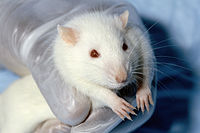
Photo from wikipedia
Mammalian models including non-human primates, pigs and rodents have been used extensively to study the mechanisms of cardiovascular disease. However, there is an increasing desire for alternative model systems that… Click to show full abstract
Mammalian models including non-human primates, pigs and rodents have been used extensively to study the mechanisms of cardiovascular disease. However, there is an increasing desire for alternative model systems that provide excellent scientific value while replacing or reducing the use of mammals. Here we review the use of zebrafish, Danio rerio, to study cardiovascular development and disease. The anatomy and physiology of zebrafish and mammalian cardiovascular systems are compared, and we describe the use of zebrafish models in studying the mechanisms of cardiac (e.g. congenital heart defects, cardiomyopathy, conduction disorders, regeneration) and vascular (endothelial dysfunction and atherosclerosis, lipid metabolism, vascular ageing, neurovascular physiology and stroke) pathologies. We also review the use of zebrafish for studying pharmacological responses to cardiovascular drugs, and describe several features of zebrafish that make them a compelling model for in vivo screening of compounds for the treatment cardiovascular disease.
Journal Title: British journal of pharmacology
Year Published: 2021
Link to full text (if available)
Share on Social Media: Sign Up to like & get
recommendations!